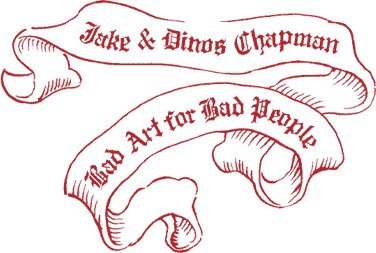Jake and Dinos Chapman
dal 14/12/2006 al 3/3/2007
Segnalato da
14/12/2006
Jake and Dinos Chapman
Tate Liverpool, Liverpool
Bad Art for Bad People? Over the past decade, they have provocatively addressed some of the most pertinent and controversial issues facing society. This exhibition presents important works from all phases of their career, revealing a diverse body of work in many media. Taking their sculpture Little Death Machine (Castrated) 1993, now in the Tate Collection, as a point of departure, the Chapmans have created a series of improbable machines that emulate human functions such as breathing, thinking or sexual intercourse.

Jake and Dinos Chapman (born in 1962 and 1966 respectively) are among the most significant and best-known contemporary British artists working today. Together they have created an exceptional body of work which draws from all areas of culture including philosophy, art history and cultural theory. To coincide with their mid-career exhibition at Tate Liverpool (15 December 2006 - 4 March 2007) they are creating a new installation especially for Tate Britain. Taking their sculpture Little Death Machine (Castrated) 1993, now in the Tate Collection, as a point of departure, the Chapmans have created a series of improbable machines that emulate human functions such as breathing, thinking or sexual intercourse. In their subversive wit and black humour, the works recall the disturbing sexual fetishism and fascination with dismemberment of the Surrealists.
Entry to the exhibition is free. It is accompanied by an exhibition catalogue, produced by Tate Liverpool which is the first publication to take an overview of the Chapmans work to date, and includes working drawings and installation shots relating to the new work.
Introduction: Bad Art for Bad People?
Jake and Dinos Chapman are leading British contemporary artists who came to prominence during the 1990s as part of the generation of so-called YBAs (Young British Artists). Since that time they have created a substantial, highly intelligent and challenging body of work that addresses the very heart of human experience and moral behaviour. They interrogate what we value as art, questioning the widely held view that the purpose of art is to be morally redemptive or socially edifying. They ask us to consider what we see as good or bad art - whether 'bad' art really is made by or for bad people - and to probe the assumptions that underlie established aesthetic criteria. They frequently employ subversive strategies through which they question the role of the artist and the complicity of the viewing audience.
The Chapmans' art is characterised by scepticism, parody and irreverence. It combines a vast range of influences, drawn from philosophy, critical theory, psychoanalysis, art history and popular culture. Their work engages with controversial issues including the human capacity for barbarity, war and violence, the 'banality of evil' in the twentieth and twenty-first centuries and the perpetual human preoccupation with mortality. It also addresses the transgressive realities of bodily existence as manifested in plastic surgery, genetic manipulation and cloning. A number of works tackle our assumptions about sex and sexuality, including the presumed innocence and asexuality of children, and the proximity between sex and death. Through an aesthetics of horror and disgust, they deal with the instability of moral and ideological belief systems, particularly those founded on eighteenth century Enlightenment thought, Christianity or consumerism. Another recurrent theme is the concept of originality, the validity of aesthetic appropriation and thus the nature of artistic creation itself. The painstaking craftsmanship and evident graphic facility exhibited in their work is played off against their tendency to endlessly recycle (their own and others') ideas.
---
Tate08 Series: John Armleder
15 December 2006 - 25 February 2007
John Armleder
John Armleder, a performance artist, painter, sculptor, critic, curator and expeditionary, is consistent only in his willingness to take creative risks. A member of the Geneva-based Groupe Luc Bois, he was heavily involved with Fluxus during the 1960s and 1970s and was a founder member of the Groupe Ecart in 1969, known primarily for their performances and publications. His work continues to demonstrate the preoccupations of these groups by abandoning hierarchies of different artistic genres and objects.
Armleder frequently examines the context in which art is displayed and views the exhibition as a medium in its own right. In earlier works he questioned the notion of the authenticity of art with installations that united found objects (second-hand or new) with abstract paintings executed by Armleder himself, many of which ironically referred to previous modernist examples. He creates dialogues between disparate objects by placing them within an exhibition context, raising the question of possible equivalences that are created between them when viewed in such a setting.
These concerns remain evident in his most recent body of work, such as this gallery-filling installation made especially for Tate Liverpool. Using a multitude of materials including televisions, scaffolding, mirrors, lights, CD players, animals, pot plants and Christmas trees, he has created a riotous and magical world of disorientating beauty and mystery.
Born in Geneva in 1948, Armleder studied at the Ecole des Beaux-Arts, Geneva (1966-7) and at the Glamorgan Summer School, Britain (1969). He is currently based in Geneva, but lives and works in continual activity around the globe.
Supported by Tate08 Partners
With additional support from Pro Helvetia, Swiss Arts Council
Tate Liverpool
Albert Dock L3 - Liverpool
Exhibition Hours: Tuesday-Sunday 10.00-17.50 Closed Mondays (except Bank Holiday Mondays)



